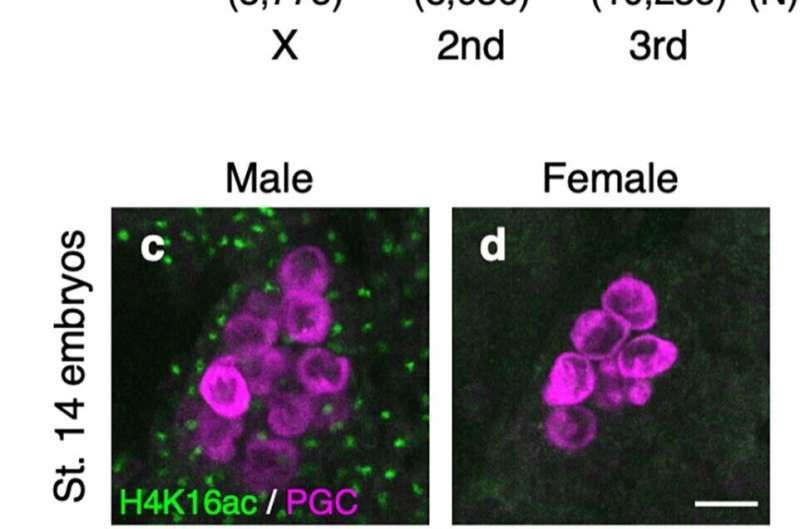X marks the spot: How genes on the sex chromosomes are controlled

Because human females have two X chromosomes and males have one X and one Y, somatic cells have special mechanisms that keep expression levels of genes on the X chromosome the same between both sexes. This process is called dosage compensation and has been extensively studied in the fruit fly Drosophila. Now, researchers at the University of Tsukuba (UT) continued work with Drosophila to show that dosage compensation does not occur in the germ cells of male flies.
In an article published in Scientific Reports, the UT researchers investigated this phenomenon in fly primordial germ cells (PGCs), which are present in embryos and are the precursor cells to what ultimately become sperm and eggs in adults. Previous reports on dosage compensation in this cell type were controversial.
Genetic research in somatic cells has shown that expression of X-linked genes in male fruit flies is upregulated to reach equivalent levels to that of their female counterparts. A group of proteins, called the male-specific lethal (MSL) complex, is responsible for carrying out this role. These findings made the UT group interested in if this mechanism also occurs in the male germ cells. Distinct molecular events occur in the PGCs during embryonic development between male and female fruit flies. Because results shown in earlier publications did not align, the researchers chose to address their main question differently.
"The MSL complex leaves a signature mark, called acetylation, on a specific amino acid of the histone H4 protein of the X chromosome," says Professor Satoru Kobayashi, senior author of the study. "The acetyl group being added tells the cell to express the X-linked genes at a higher level, which results in dosage compensation."
To address their questions, the researchers used a process called transcriptome analysis to compare gene expression levels between male and female fruit fly PGCs. They also examined the histone H4 protein to determine if acetylation had occurred.
"We found that X-linked gene expression in male PGCs was about half that of female PGCs," describes Professor Kobayashi. "We also could not detect the acetylation signature of the MSL complex."
The authors also determined that the main components of the MSL complex are only present in very low amounts in the fly PGCs. Interestingly, they then created transgenic flies that were engineered to express higher levels of the MSL complex proteins. Male PGCs in these flies showed greater activation of X-linked genes, as well as the acetylation signature.
The researchers believe that the findings of this study have high biological significance, possibly suggesting that the absence of dosage compensation affects sex determination in Drosophila PGCs. This work provides novel insight that will be crucial for further investigation of embryo development and germ cell maturation.
More information: Ryoma Ota et al. Absence of X-chromosome dosage compensation in the primordial germ cells of Drosophila embryos, Scientific Reports (2021). DOI: 10.1038/s41598-021-84402-7
Journal information: Scientific Reports
Provided by University of Tsukuba




















